
From our friends at START1.org:
The healing power of the sea has been known for centuries.
The Greeks and Chinese in 4500 BC began using the sea as a source of commerce and food. The ancient Egyptians and Greeks investigated the effects of seawater on human health, crediting it with healing powers. As early as the 14th century, Eastern cultures recognized the medical properties of organisms found in coral reefs. During medieval times in Europe, sea bathing was thought to have curative or therapeutic value. Marine bioresources have been part of folk medicines used for centuries by indigenous cultures. Yet most of our present day medicines come from plants, animals or microbes. Today, scientists are saying the oceans could hold the key to finding the next generation of life saving drugs.
The oceans cover more than two thirds of Earth’s surface but 95 percent of the ocean has yet to be explored. However, with advances in technology we now have the underwater technology to explore the seas and oceans and the means to undertake DNA sequencing to analyze its life. Submersibles and remotely operated vehicles are being used by scientist to send specialized laboratories to the deep seafloor in order to observe and sample the deep ocean, opening up these previously unexplored areas to scientists.
With these advances we have seen a rapid increase in marine bioprospecting and blue biotechnology. The Global Ocean Commission defines marine bioprospecting as “the search for novel compounds from natural sources in the marine environment.” Blue biotechnology is concerned with the application of molecular biological methods to marine and freshwater organisms.
Even with only 5 percent of the oceans explored a number of medical discoveries have been made. A large, shallow water sponge found in the Caribbean has been discovered to generate compounds used in AZT which is used to fight AIDS. A soft coral, the Caribbean gorgonian, has been found to produce a group of compounds with anti-inflammatory properties that could be used for treating asthma and arthritis. Skates, a flat fish, have provided clues that have aided in treating vision loss. Corals and mollusks are being used to make orthopedic and cosmetic surgical implants. Cone snails produce venom that is used as an analgesic, more potent than morphine. A tentacled aquatic organism called bryozoan yields a compound being tested as a cancer drug. Scientists say unusual compounds and gene sequences in some marine creatures and plants could lead to much needed new medicines from antibiotics to cancer drugs. Exploration of the sea biodiversity could enable us to develop many more new pharmaceuticals.
With these advances come concerns that without regulation fragile habitats could be damaged beyond repair. Overuse, sustainability and the legal right to use waters not covered by treaties are also cited. Despite those concerns, drugs from the ocean are one of the most promising directions of science today as it becomes the biological focus for discovering 21st century medicines.


